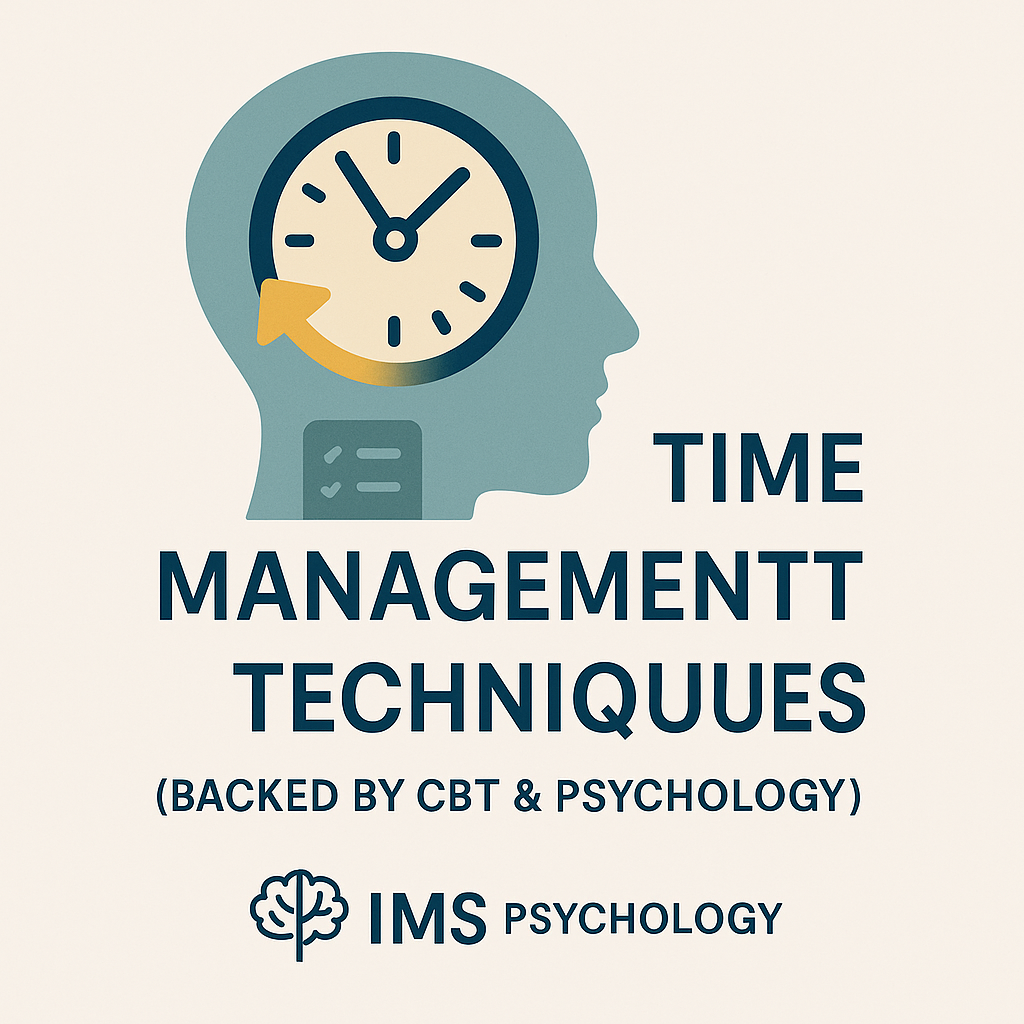
Time Management Techniques (Backed by CBT & Psychology)
Share
Time Management Techniques (Backed by CBT & Psychology)
Discover time management techniques grounded in CBT and psychology. Learn evidence-based strategies to beat procrastination, boost focus, and manage your day effectively.
Introduction: Why Time Slips Away
Most people know the feeling of staring at a growing to-do list, feeling paralyzed by procrastination or overwhelmed by pressure. While time management is often framed as a matter of productivity hacks, psychology shows it is also deeply connected to mindset, emotions, and behavior.
Cognitive Behavioral Therapy (CBT) and related psychological approaches reveal that how we think about time influences how we use it. This guide explores practical, evidence-based techniques to help you regain control of your schedule without burning out.
The Psychology of Time Management
Time management struggles are rarely just about poor planning — they are often linked to:
-
Cognitive distortions (e.g., “I’ll never finish, so why start?”).
-
Emotional avoidance (avoiding tasks that feel stressful or overwhelming).
-
Perfectionism (delaying action until conditions feel “just right”).
-
Executive function challenges (difficulty prioritizing, organizing, or focusing).
By understanding these mental patterns, you can design strategies that address both behavior and thinking styles.
Time Management Techniques Backed by Psychology
1. Cognitive Restructuring for Procrastination (CBT)
Procrastination often comes from distorted thinking:
-
“It has to be perfect.”
-
“I’ll fail if I try.”
-
“I work better under pressure.”
CBT Approach:
-
Identify the thought.
-
Challenge it with evidence.
-
Replace it with a balanced belief: “Progress matters more than perfection. Starting now reduces stress later.”
2. The Pomodoro Technique (Behavioral Activation)
Originating from behavioral psychology, the Pomodoro method uses short bursts of focused work followed by breaks.
-
Work for 25 minutes → Take a 5-minute break.
-
After 4 rounds, take a longer 15–30-minute break.
This combats avoidance by breaking tasks into manageable steps and rewarding effort with rest.
3. Time Blocking (Executive Function Training)
Time blocking involves scheduling specific periods for specific activities. Instead of a vague “I’ll work on it later,” you commit: “From 2–3 p.m., I’ll focus only on this report.”
Why it works: It reduces decision fatigue, limits multitasking, and builds consistency.
4. The Two-Minute Rule (Overcoming Avoidance)
From productivity psychology: If a task takes less than two minutes, do it immediately.
-
Clears mental clutter.
-
Builds momentum by reducing procrastination triggers.
5. SMART Goal-Setting (CBT & Motivation Science)
Tasks feel overwhelming when goals are vague. SMART goals are:
-
Specific: What exactly do I need to do?
-
Measurable: How will I know it’s done?
-
Achievable: Is it realistic?
-
Relevant: Does it matter to my values and priorities?
-
Time-bound: When will I finish?
CBT emphasizes linking goals to realistic steps, reducing overwhelm.
6. Cognitive Defusion (ACT Approach)
Acceptance and Commitment Therapy (ACT) teaches defusion — stepping back from unhelpful thoughts.
-
Instead of “I’ll never finish this,” try: “I’m noticing I’m having the thought that I’ll never finish this.”
This reduces the thought’s power and allows you to act despite anxiety.
7. Implementation Intentions (“If-Then” Planning)
Psychology research shows that linking behavior to cues improves follow-through:
-
“If it’s 8 a.m., then I’ll write for 20 minutes.”
-
“If I check my email, then I’ll only respond for 10 minutes.”
This technique makes time management automatic rather than willpower-driven.
8. Prioritization Frameworks
-
Eisenhower Matrix: Sort tasks into urgent/important quadrants.
-
Pareto Principle (80/20 Rule): Focus on the 20% of tasks that deliver 80% of results.
These tools help shift from busywork to meaningful work.
9. Mindfulness for Time Awareness
Research shows mindfulness reduces procrastination by increasing present-moment awareness. Techniques include:
-
Starting the day with a short breathing exercise.
-
Using mindful breaks to reset focus.
-
Practicing “single-tasking” instead of multitasking.
10. Self-Compassion as a Time Tool
People often lose hours to self-criticism after procrastinating. Research shows self-compassion improves motivation more than shame.
-
Replace “I wasted the morning, I’m useless” with: “It was a hard start, but I can choose differently now.”
Why Willpower Alone Isn’t Enough
Time management isn’t just about self-discipline — it’s about designing systems that align with psychology.
-
Habits > Motivation: Consistency comes from routine, not waiting for inspiration.
-
Environment > Willpower: Removing distractions is more effective than relying on mental strength.
-
Compassion > Criticism: Resilience grows when we support ourselves, not when we punish.
When to Seek Support
If procrastination, poor focus, or time management struggles are linked to anxiety, ADHD, or depression, therapy or coaching can provide tailored strategies.
Practical Tools You Can Use Today
IMS Psychology offers downloadable, evidence-based workbooks that blend CBT and productivity science. Our [Time Management & Productivity Workbook] provides structured exercises, daily planners, and cognitive reframing tools to help you take back control of your time.
Conclusion: Building a Healthy Relationship With Time
Time management isn’t about squeezing every second for productivity — it’s about creating balance, clarity, and focus. By applying CBT techniques, mindfulness, and practical scheduling tools, you can break free from procrastination and design a day that supports both achievement and well-being.
If you’d like to practice these strategies with guided exercises, explore the IMS Psychology workbooks, designed to turn psychological insight into practical daily tools.
written by,
Martin Rekowski (01.10.2025)
External Source
American Psychological Association – Why We Procrastinate
https://www.apa.org/news/podcasts/speaking-of-psychology/procrastinate